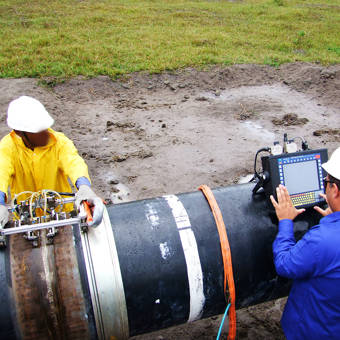Secure Your Financial Investment: Thorough Pipeline Welding Inspection for Comfort
Secure Your Financial Investment: Thorough Pipeline Welding Inspection for Comfort
Blog Article
Comprehensive Overview of Pipeline Welding Assessment Treatments
Pipeline welding evaluation procedures play an important duty in guaranteeing that welded links satisfy rigid industry criteria and specifications. From careful pre-welding examinations to detailed post-weld analyses, a distinct examination process is important for keeping the structural stability of pipelines.
Pre-welding Evaluation Preparations
Prior to starting the welding process, complete pre-welding evaluation preparations are necessary to guarantee the integrity and high quality of the weld joint. These prep work include a precise evaluation of the products to be bonded, the welding devices, and the workplace. The materials must be examined for any defects, impurities, or incongruities that could endanger the weld. This includes monitoring for correct material grades, measurements, and surface problems. Pipeline Welding Inspection. In addition, the welding devices needs to be inspected to verify that it is in good working problem, calibrated properly, and appropriate for the particular welding procedure. Any type of problems with the tools ought to be attended to promptly to avoid flaws in the weld. Last but not least, the workplace should be evaluated for tidiness, appropriate air flow, and safety and security steps to make sure a favorable setup for the welding procedure. By performing extensive pre-welding examination prep work, possible problems can be determined and fixed at an early stage, bring about reliable and high-quality weld joints.
Welding Treatment Certification
Comprehensive pre-welding assessment prep work lay the structure for the crucial process of Welding Treatment Qualification, guaranteeing the integrity and top quality of the weld joint. Welding Procedure Certification (WPQ) is a vital action in the welding process that includes screening and accrediting welding treatments to guarantee they satisfy specific requirements and demands. The WPQ procedure usually consists of welding procedure requirements development, welding procedure credentials testing, and paperwork of the outcomes.
During welding treatment specification advancement, essential details such as the welding process, welding materials, joint style, and welding criteria are defined to produce a thorough procedure. Subsequently, welding procedure credentials testing is carried out to confirm the recommended procedure's honesty. This testing commonly involves welding examination coupons that undergo various mechanical and non-destructive examinations to analyze the weld's high quality and adherence to the specified standards.
In-process Weld Examination
During the welding procedure, in-process weld inspection plays an essential role in making certain the quality and integrity of the weld joint - Pipeline Welding Inspection. This type of assessment entails monitoring the welding specifications, examining the weld bead formation, and finding any kind of potential issues or interruptions as they happen. By carrying out in-process weld YOURURL.com inspections, welding drivers can promptly address any kind of issues that may develop, thereby protecting against more issues and making certain that the last weld satisfies the needed specifications
Common approaches utilized for in-process weld inspection include aesthetic assessment, fluid penetrant testing, magnetic bit screening, ultrasonic screening, and radiographic screening. Overall, in-process weld assessment is important for preserving the top quality and reliability of welded pipes.
Non-destructive Screening (NDT)
Non-destructive Testing (NDT) is an important approach employed in pipeline welding assessment to assess the stability of weld joints without triggering damages to the welded structure. By using numerous NDT techniques, assessors can review the high quality of welds and determine any problems or suspensions that might jeopardize the structural soundness of the pipeline. Typical NDT approaches made use of in pipe welding examination consist of Radiographic Screening (RT), Ultrasonic Screening (UT), Magnetic Fragment Testing (MPT), Liquid Penetrant Screening (LPT), and Visual Testing (VT)
RT includes the use of X-rays or gamma rays to produce photos of the inner framework of the weld, permitting inspectors to identify defects such as porosity, fractures, or insufficient blend. In addition, VT entails aesthetic examination of welds to recognize any kind of visible blemishes.
Post-weld Examination and Paperwork

Documentation of post-weld examination findings is necessary for preserving quality assurance documents and ensuring conformity with market standards and laws. In-depth reports ought to consist of information concerning the evaluation click this site approaches used, the area and nature of any flaws found, and any type of rehabilitative actions taken - Pipeline Welding Inspection. Correct documentation not just functions as a record of the weld's top quality but also aids in future upkeep and evaluation procedures
Final Thought

In conclusion, pipeline welding examination procedures play a critical role in guaranteeing the high quality and honesty of welds. In general, adherence to correct evaluation methods is essential to the success of pipe welding projects.
From careful pre-welding evaluations to detailed post-weld analyses, these details a well-defined evaluation procedure is crucial for maintaining the architectural soundness of pipes. By carrying out in-process weld inspections, welding operators can immediately resolve any problems that may emerge, thus stopping additional flaws and guaranteeing that the final weld meets the called for requirements.
Typical methods used for in-process weld examination consist of visual inspection, fluid penetrant testing, magnetic fragment screening, ultrasonic screening, and radiographic testing.Non-destructive Screening (NDT) is a critical approach utilized in pipeline welding examination to evaluate the integrity of weld joints without creating damage to the bonded structure. Post-weld examination includes various approaches to evaluate the welds for flaws, consisting of aesthetic inspection, color penetrant testing, magnetic bit screening, ultrasonic testing, and radiographic screening.
Report this page